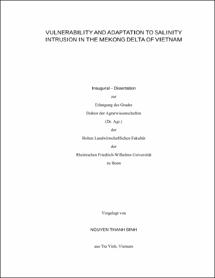Binh, Nguyen Thanh: Vulnerability and adaptation to salinity intrusion in the Mekong delta of Vietnam. - Bonn, 2015. - Dissertation, Rheinische Friedrich-Wilhelms-Universität Bonn.
Online-Ausgabe in bonndoc: https://nbn-resolving.org/urn:nbn:de:hbz:5n-39244
Online-Ausgabe in bonndoc: https://nbn-resolving.org/urn:nbn:de:hbz:5n-39244
@phdthesis{handle:20.500.11811/6230,
urn: https://nbn-resolving.org/urn:nbn:de:hbz:5n-39244,
author = {{Nguyen Thanh Binh}},
title = {Vulnerability and adaptation to salinity intrusion in the Mekong delta of Vietnam},
school = {Rheinische Friedrich-Wilhelms-Universität Bonn},
year = 2015,
month = jun,
note = {The overall objective of this study is aimed at measuring the vulnerability of different social groups to salinity intrusion and related issues in coastal communities of the Mekong delta to improve our understandings on slow-onset hazards as salinity intrusion which receive less attention on one hand and help decision makers develop suitable adaptation measures on the other hand. The study employed a combination of quantitative and qualitative research methods to measure vulnerability. First, a participatory vulnerability analysis approach was used to identify the most vulnerable groups and their capacities. Second, by using factor analysis technique based on 512 respondents at household level, twenty indicators belong to three elements of vulnerability such as exposure, susceptibility and adaptive capacity were selected to construct a vulnerability index. The results showed that salinity intrusion, freshwater scarcity, drought and tidal influences are the most important hazards in the coastal areas of the Mekong delta and they seem to be increased recent years. To cope with and to adapt to such hazards the governments and local people have been developed many strategies and measures including dyke buildings, changes in farming techniques, financial supports for production recovery from disasters, ground water exploitation and income diversifications. However, the current adaptation options have shown some limitations because they do not fully consider the differences in terms of ecological, social and economic environments. The results obtained with the help of composite indicators depicted that the vulnerability of people highly depends on such conditions. Therefore, future adaptation strategies should take into account these in order to identify different social groups, especially the most vulnerable ones as the poor, minority ethnic groups and people living outside the dyke systems. Through the study, a VAFSLO framework (Vulnerability Assessment Framework for Slow-onset hazard) and LIWISLO approach (Living With Slow-onset hazard) have been developed which can be used for vulnerability assessment and management of slow-onset hazards, especially under climate change and sea level rise contexts.},
url = {https://hdl.handle.net/20.500.11811/6230}
}
urn: https://nbn-resolving.org/urn:nbn:de:hbz:5n-39244,
author = {{Nguyen Thanh Binh}},
title = {Vulnerability and adaptation to salinity intrusion in the Mekong delta of Vietnam},
school = {Rheinische Friedrich-Wilhelms-Universität Bonn},
year = 2015,
month = jun,
note = {The overall objective of this study is aimed at measuring the vulnerability of different social groups to salinity intrusion and related issues in coastal communities of the Mekong delta to improve our understandings on slow-onset hazards as salinity intrusion which receive less attention on one hand and help decision makers develop suitable adaptation measures on the other hand. The study employed a combination of quantitative and qualitative research methods to measure vulnerability. First, a participatory vulnerability analysis approach was used to identify the most vulnerable groups and their capacities. Second, by using factor analysis technique based on 512 respondents at household level, twenty indicators belong to three elements of vulnerability such as exposure, susceptibility and adaptive capacity were selected to construct a vulnerability index. The results showed that salinity intrusion, freshwater scarcity, drought and tidal influences are the most important hazards in the coastal areas of the Mekong delta and they seem to be increased recent years. To cope with and to adapt to such hazards the governments and local people have been developed many strategies and measures including dyke buildings, changes in farming techniques, financial supports for production recovery from disasters, ground water exploitation and income diversifications. However, the current adaptation options have shown some limitations because they do not fully consider the differences in terms of ecological, social and economic environments. The results obtained with the help of composite indicators depicted that the vulnerability of people highly depends on such conditions. Therefore, future adaptation strategies should take into account these in order to identify different social groups, especially the most vulnerable ones as the poor, minority ethnic groups and people living outside the dyke systems. Through the study, a VAFSLO framework (Vulnerability Assessment Framework for Slow-onset hazard) and LIWISLO approach (Living With Slow-onset hazard) have been developed which can be used for vulnerability assessment and management of slow-onset hazards, especially under climate change and sea level rise contexts.},
url = {https://hdl.handle.net/20.500.11811/6230}
}






